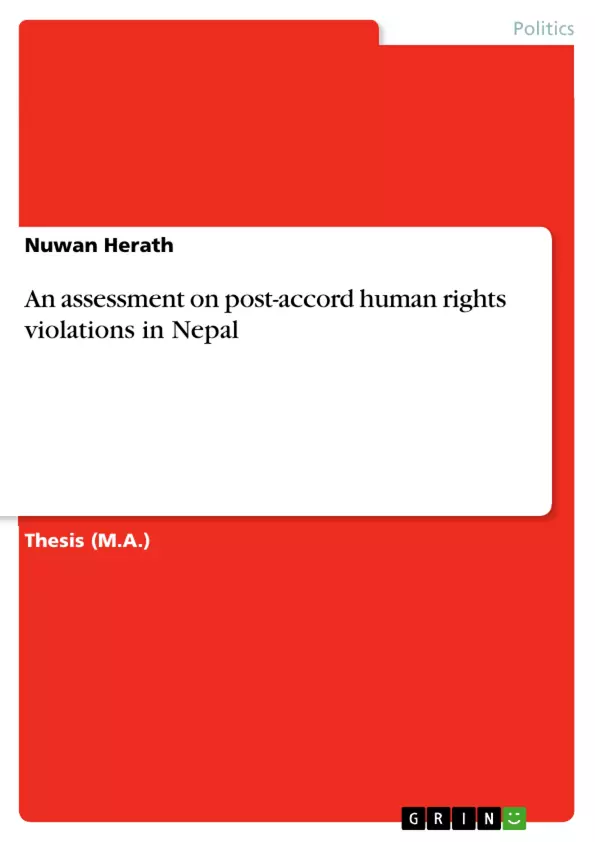This study focuses on post-accord human rights situation in Nepal and attempts to explain geographical and demographic variations in pattern of violence perpetrated by various non-state actors, the Maoist party and the state. Analysis performed in this study confirms most of the expectations regarding susceptibility of districts and geographic/development regions given certain population characteristics, emergence of non-state armed groups along with proliferation of weapons in post-accord period. The overall pattern suggests that human rights violation incidents had declined after signing of an agreement but non-state actors were responsible for most of human rights violation acts in post-accord Nepal. Findings from this study confirms early studies that on human rights situation in Nepal. Nevertheless, this study provides more sophisticated analysis and suggests where one would expect to see more human rights violation and who would be most likely to perpetrate acts of human rights violations.
Inhaltsverzeichnis (Table of Contents)
- Chapter 1: Introduction
- 1.1 Background
- 1.2 An Overview on Human Rights Violations in Nepal
- 1.3 Research Problem
- Chapter 2: Literature Review and Conceptual Framework
- 2.1 Conceptual Framework
- 2.2 Violence Patterns
- 2.3 Population variables and Human Rights Violations
- Chapter 3: Research Objective and Methodology
- 3.1 Objective of the Study
- 3.2 Research Methodology
- 3.3 Limitations
- Chapter 4: Data analysis
- 4.1 Human Rights Situations in General
- 4.2 Human Rights Violations and Victims
- 4.3 Levels of Human Rights Violations in Various Regions
- 4.3.1 Development Regions and Violence
- 4.3.2 Geographical Regions and Violence
- 4.4 Population Variables and Post - Accord Human Rights Violations
- 4.4.1 Population and Actors of Human Rights Violations
- 4.4.2 Youth Population and Human Rights Violations
- 4.5 Armed Groups, Small Arms Incidents and Human Rights Violations
- Chapter 5: Summary of findings
- 5.1 General Findings
- 5.2 Specific Findings
- 5.2.1 Various Regions and Human Rights Violations
- 5.2.2 Population Variables and Human Rights Violations
- 5.2.3 Armed Groups, Small Arms and Human Rights Violations
Zielsetzung und Themenschwerpunkte (Objectives and Key Themes)
This thesis aims to assess human rights violations in Nepal after the 2006 peace agreement, considering factors such as regional disparities, demographic variables, and the role of armed groups. The work analyzes data on human rights incidents and victims to understand patterns and trends in post-accord violations. * Analyzing post-accord human rights violations in Nepal. * Examining the impact of regional disparities on human rights violations. * Investigating the relationship between population variables and human rights violations. * Assessing the role of armed groups and small arms incidents in human rights violations. * Identifying key actors involved in human rights violations.Zusammenfassung der Kapitel (Chapter Summaries)
Chapter 1 introduces the research problem and provides background information on human rights violations in Nepal. It highlights the context of the peace agreement and the ongoing challenges related to human rights. Chapter 2 examines the existing literature and develops a conceptual framework for analyzing human rights violations. It explores patterns of violence and the influence of demographic variables on human rights. Chapter 3 outlines the research objectives and methodology, including data sources and limitations of the study. Chapter 4 presents the data analysis, focusing on human rights violations across various regions and their relationship with population characteristics. It examines the role of different actors and the impact of small arms incidents. Chapter 5 summarizes the findings of the study, highlighting key observations and patterns related to human rights violations in Nepal after the peace agreement.Schlüsselwörter (Keywords)
This research focuses on post-accord human rights violations in Nepal, exploring themes related to regional disparities, population variables, and the role of armed groups. Key concepts include peace agreements, human rights, violence patterns, demographic factors, and small arms incidents. The analysis emphasizes the impact of different actors and their involvement in human rights violations.- Citation du texte
- Nuwan Herath (Auteur), 2013, An assessment on post-accord human rights violations in Nepal, Munich, GRIN Verlag, https://www.grin.com/document/274497



